Coconut Beef Curry Recipe
This beef curry is sweet, savory, and aromatic with just the right touch of gentle heat. Seared beef and fresh veggies are slow-cooked to tender perfection in a rich coconut curry sauce along with onions, garlic, ginger, and loads of other robust spices.
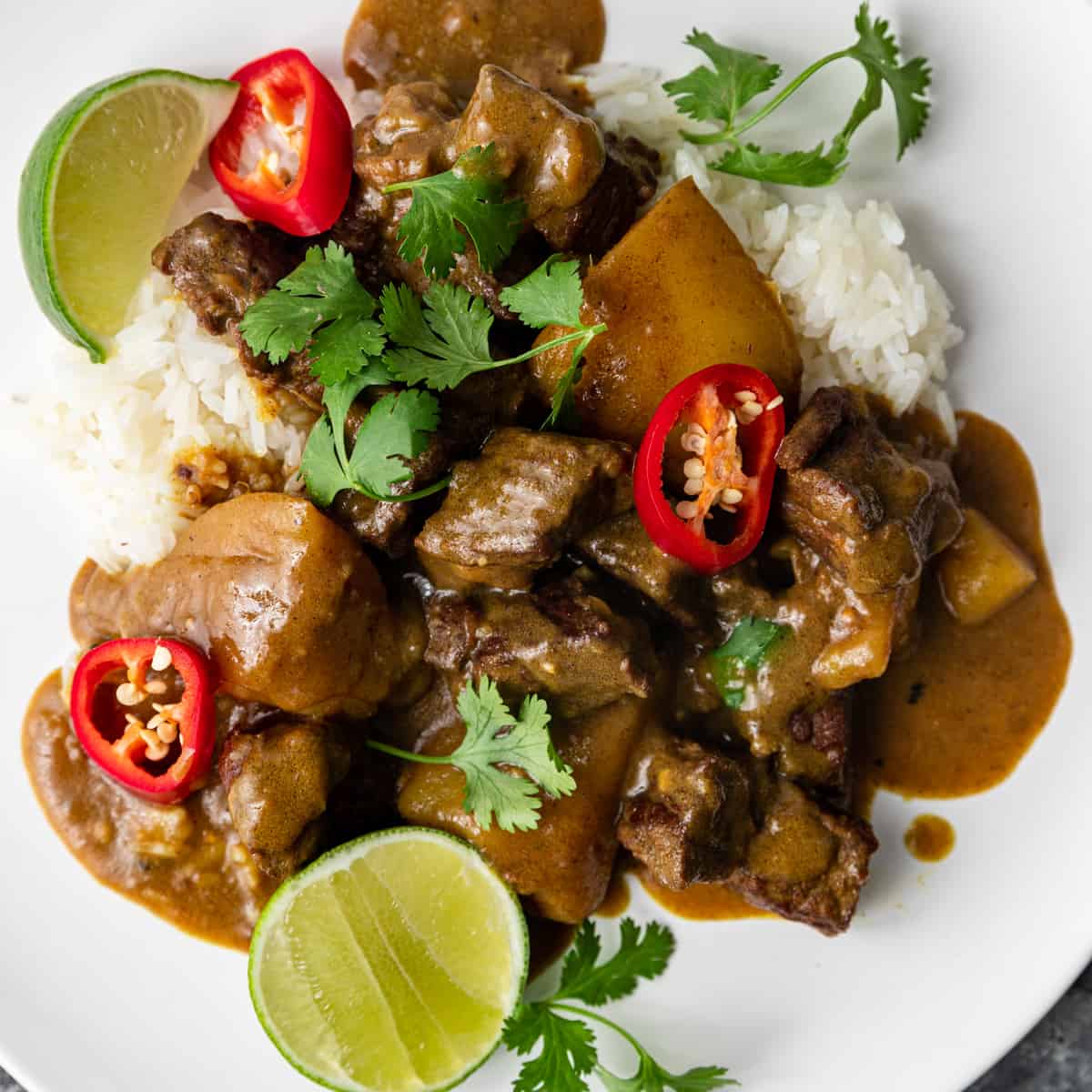
This beef curry is an instant crowd-pleaser! With everything you love about a delicious curry dish, who could complain?
Coconut beef curry features succulent, savory beef, tender veggies, aromatic herbs, and rich spices all delivered in a creamy, comforting stew-like dish. Imagine all the comfort of your Grandmother’s beef stew with a delicious Asian twist!
This beef curry recipe is not difficult to make, but it does require a bit of patience. You need about an hour and a half from start to finish, making it perfect for nights when you have a bit more time.
Secret Flavor Weapon!
The secret ingredient that makes this dish shine is S&B Curry Powder, which hails from Japan. You can find the bright red can with yellow writing in most markets or Asian stores. It’s filled with all of the traditional spices and herbs of curry powder. I’m talking about things like turmeric, coriander, fenugreek, cumin, red and black pepper, cinnamon, and more. It’s a lot sweeter than Indian curry powder or Madras curry powder, which are usually quite spicy.

- Beef – I use beef chuck for this coconut beef curry stew recipe. Make sure to cut up the pieces into 1-inch or thinner slices.
- Onion & Garlic – This is where much of the flavor of the dish gets started. You’ll sauté them together with fresh ginger.
- Ginger – Opt for fresh over powdered for your coconut beef curry stew! In a pinch, you can substitute ginger paste.
- S&B Curry Powder – I’ve already mentioned this curry powder — it truly makes this dish. It boasts warm and aromatic flavors and isn’t too spicy. You should be able to locate it at your local supermarket. Otherwise, check online.
- Coconut Milk – You’ll need unsweetened varieties for this dish as the curry powder above is already slightly sweet. Go for full-fat, not light.
- Vegetable Oil – To brown the beef and sauté the onion, garlic, and ginger!
- Salt – Just a dash to season the beef before you brown it.
- Bay Leaves – To add even more aromatic goodness to the final results.
- Potatoes – I like to use white or Yukon Gold potatoes. You can go with your preference.
- Carrots – I just love the addition of vegetables in this coconut beef curry stew. They really round out the dish and make it even heartier.
- Chiles – Use either Fresno chiles or jalapeños as a garnish for a bit of added spice.
- Cilantro & Lime Wedges – Optional, but I love using them as a garnish as well!
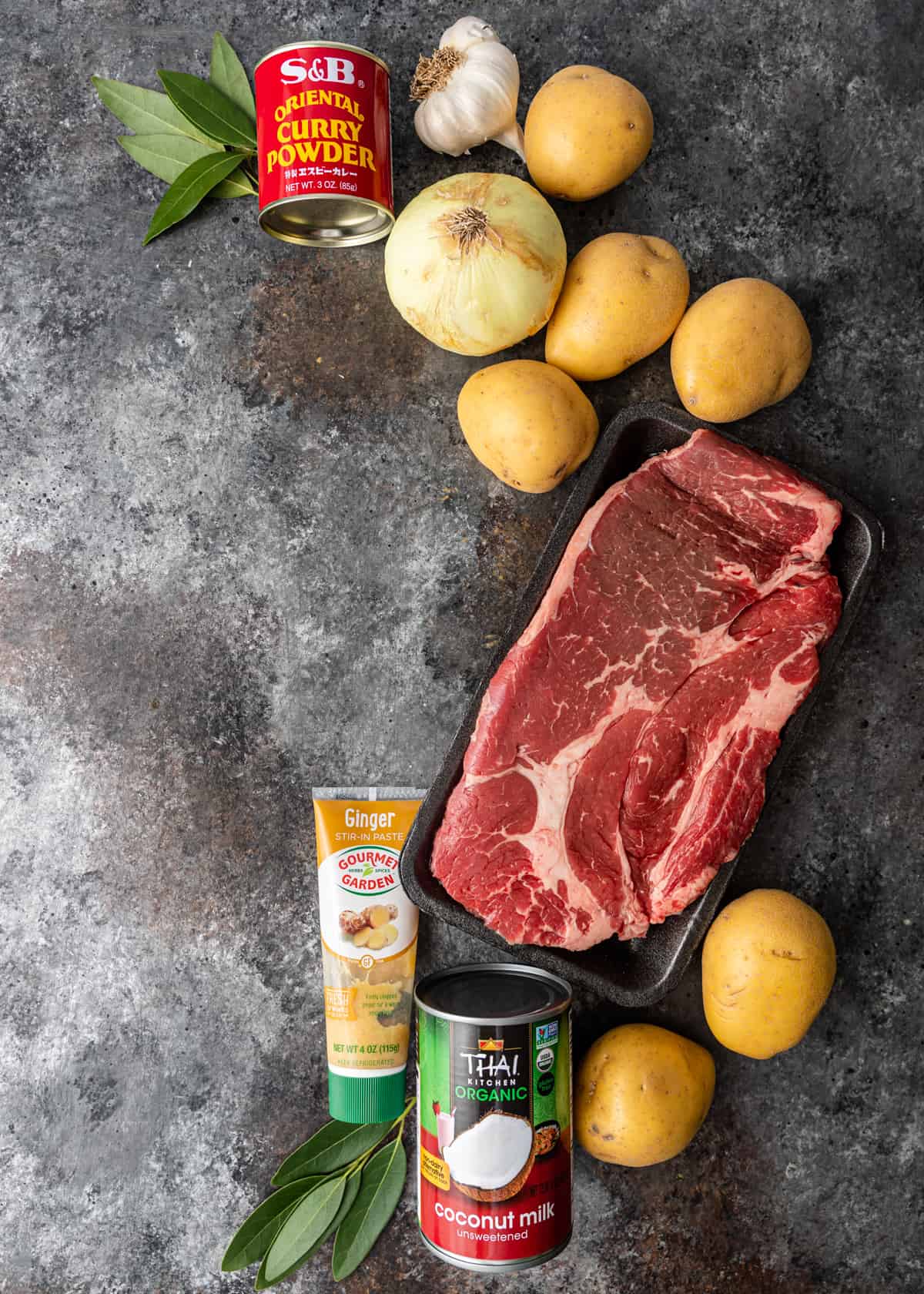
- Brown the Beef. Thoroughly season the beef with kosher salt. Place a large heavy pot with 2 tablespoons of oil over medium-high heat. Brown the beef for about 8-10 minutes, until browned on all sides, then transfer to a plate and set aside. To make sure the beef is browned rather than steamed, you’ll want to do this step in batches.
- Add the Seasonings. Turn the heat down to medium and add another tablespoon of oil to the pot. Then, toss in the onion, garlic, and ginger, and cook for about 5 minutes until the onions become translucent. Add the curry powder and cook, stirring constantly, for about 3 minutes.
- Simmer. Return the beef to the pot followed by the bay leaves, coconut milk, and 1 cup of water. Bring the pot to a boil, reduce the heat to low, and partially cover the pot. Let the curry simmer for about 35-40 minutes or until the beef is just fork-tender.
- Add the Veggies. Now, remove the lid and stir in the potatoes and carrots. Keep uncovered and cook for another 25-35 minutes until the vegetables become tender. Stir occasionally and add water if needed to thin.
- Garnish & Serve. Season with salt as desired. Spoon over rice with chopped chiles and cilantro as garnish. Finish with a squeeze of lime over the top.
Recommended Tools
- Dutch Oven or Large, Heavy Pot
- Chopping Knife
Storing and Reheating
Store leftover beef curry in an airtight container in the refrigerator for 3-4 days. In airtight, freezer-safe containers, the curry can also be frozen for up to 3 months.
Thaw any frozen portions in the refrigerator overnight before reheating. Reheat either in the microwave or in a Dutch oven placed over medium-low heat.

Types of curry
If you don’t eat curry often, you may not know that there is a difference between Thai curry and Indian curry. There are also regional differences as well. For example, the ingredients in a curry like this one are different than in my Chinese Curry Beef Stir Fry or an authentic Thai Panang Curry.
The spices
Generally speaking, curry powder and curry paste include a mixture of spices. The ingredients in the curry seasoning can affect the overall color of the dish itself. While I find most Asian curries in paste form and Indian in powder form. See below for links to try!
Indian Curry Powders
Homemade Curry Powder, Madras Curry Powder (Medium) and my Vindaloo Curry Powder (Hot).
Asian Curry Pastes
- Red curry – Usually made with red chiles. The variety of chili pepper varies by region. For example, I use birdseye chiles to make Thai red curry paste.
- Yellow curry– Turmeric is the spice that gives a glorious golden hue to the majority of yellow curries. It’s what I use in my recipe for Thai yellow curry paste.
- Green curry – Green chiles are what make green curry green. Again, the variety of chiles will vary based on if it’s an Indian or Asian recipe. Two types of green chiles are in this Thai green curry paste.
While most Indian curry recipes are tomato based, many Asian curries are coconut based.
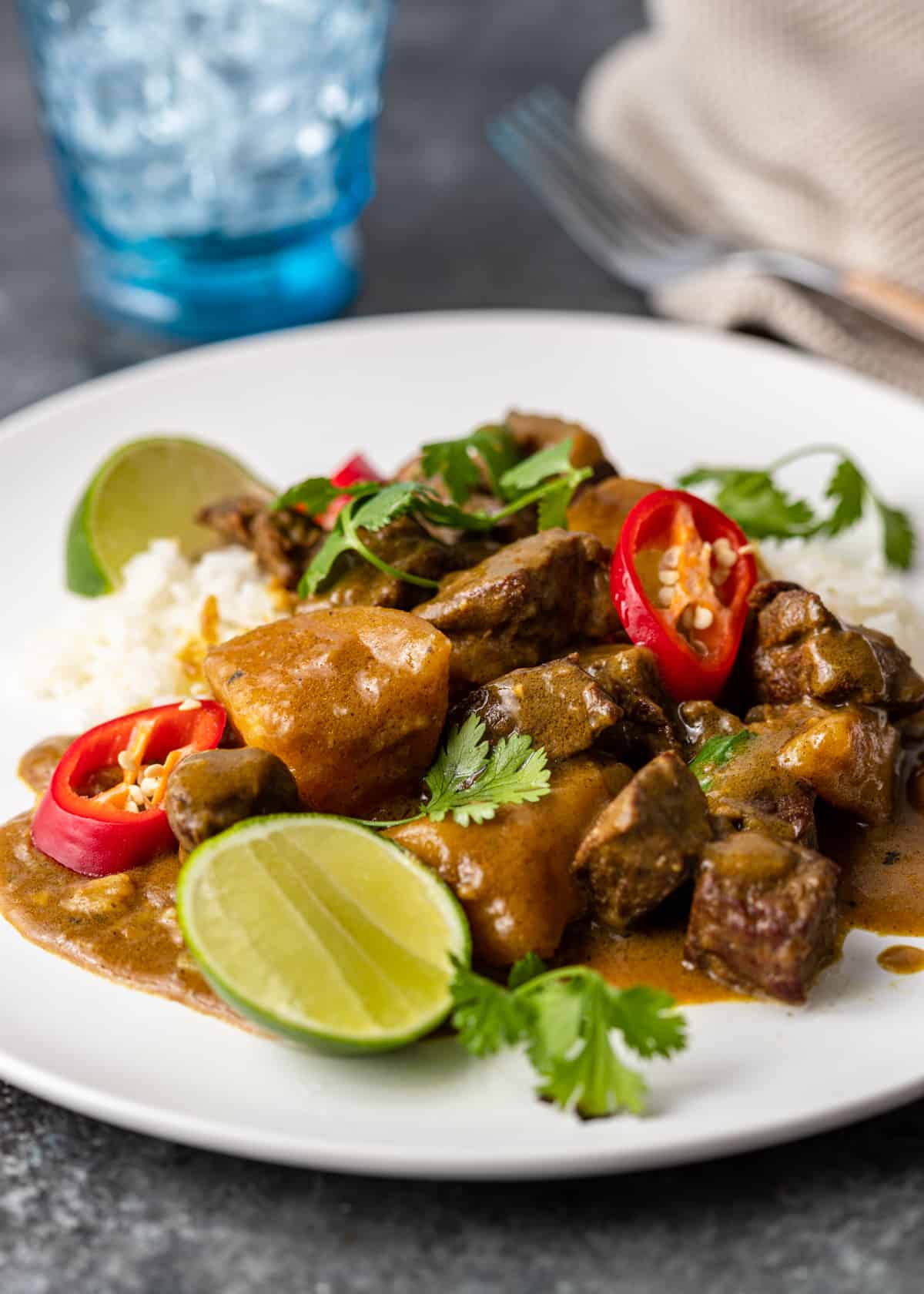
Traditionally, chuck steak is used for this beef curry. It’s also what I use here. It’s beef shoulder and it cuts up really nicely. When you cook it like a stew, it will become fork tender and will practically melt in your mouth! It’s also low in fat content if that’s a concern.
This recipe boasts a wonderfully sweet, savory, and almost umami flavor thanks to the added spices, seasonings, and aromatics. Remember: it’s also sweeter than its Indian counterparts. It’s mild and not spicy.
As for the curry powder, I prefer the Japanese S&B curry powder for this recipe. The brand can be found in the red and yellow tin based out of Japan and is stocked in most markets these days.
S&B curry, originating from Japan, differs from Indian curry powders in a few ways. S&B’s curry tends to be milder, sweeter, and has a thicker texture due to the inclusion of ingredients like wheat flour. It often contains a blend of spices like turmeric, cumin, fenugreek, and coriander, but the ratios and additional elements set it apart. Indian curry powders, on the other hand, can vary widely in heat, spice complexity, and ingredients based on regional variations, often emphasizing a stronger, more diverse spice profile with components like cardamom, cloves, and various chili peppers.
There are a few key factors for success when making this beef curry recipe. Here are a few of my top pointers for delicious results every time:
Choose the right cut of beef. Go with meat cuts that have plenty of marbling and will stand up to the slow cooking process. Beef chuck is my favorite choice for beef curry.
Don’t overcrowd the pan. This is important when browning the beef in the beginning. Overcrowding will cause the meat to steam, so you won’t get the rich development of flavor that the browning process offers.
Chop your veggies uniformly. This helps make sure all your potatoes and carrots are fully and evenly cooked.
Japanese beef curry is a satisfying meal when served over a bed of simple white rice like Basmati or Jasmine Rice. It can also be served with Hibachi Fried Rice or your choice of rice noodles.
To build a larger, Asian-themed meal, you can start with appetizers like Japanese Cucumber Salad and a hot bowl of Miso Soup. Spring Rolls can make another excellent addition to the table.
Share this recipe on Pinterest!
Love this recipe? Share it with the world on Pinterest.

Coconut Beef Curry Recipe
Ingredients
- 1 1/2 lbs beef chuck (See Note 1)
- 1 tsp kosher salt
- 3 tbsp vegetable oil divided
- 1 yellow onion medium thinly sliced
- 4 garlic cloves minced
- 2 tbsp fresh ginger peeled, finely chopped or paste
- 3 tbsp S&B Oriental curry powder preferable (See Note 2)
- 3 bay leaves
- 27 oz unsweetened coconut milk two 13.5 oz cans (not light, full fat)
- 2 lbs White or Yukon Gold potatoes cut into 2-inch pieces
- 2 large carrots peeled and sliced
Toppings
- 1 Fresno chiles sliced thin or jalapeno
- Cilantro
- Lime wedges
Instructions
- Season beef all over with kosher salt. Heat 2 tablespoons of oil in a large heavy pot over medium-high heat. Working in batches (you want the beef browned, not steamed), cook beef until browned on all sides, 8–10 minutes. Transfer to a plate.
- Reduce heat to medium and add remaining tablespoon of oil, onion, garlic, and ginger. Cook until onion is translucent, about 5 minutes. Add curry powder and cook, stirring, about 3 minutes.
- Return beef to pot along with bay leaves, coconut milk, and 1 cup water. Bring to a boil, turn heat to low and simmer partially covered, until beef is just fork tender, 30–35 minutes.
- Add the potatoes and carrots and cook uncovered, stirring occasionally, until beef and vegetables are tender, 25–35 minutes. Thin with water if needed. Season with salt if needed. Serve over rice, topped with cilantro and sliced chiles. Squeeze a lime wedge on top to balance the umami flavors.
Video
Notes
- Cut the beef cut into 1-inch pieces, or thinner slices.
- My go to curry powder is made by S&B from Japan and can be found in most markets in a red and yellow tin. Warm flavors, aromatic, and easy on the spicy heat.
- Adapted from Shuai Wang, Bon Appetit.
Nutrition
The information shown is an estimate provided by an online nutrition calculator. It should not be considered a substitute for a professional nutritionist’s advice.


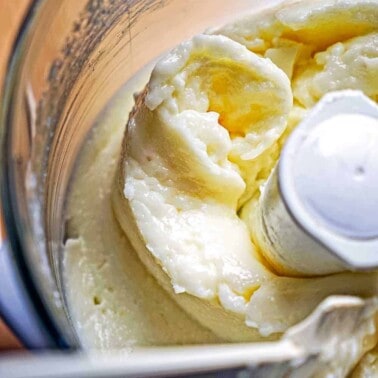
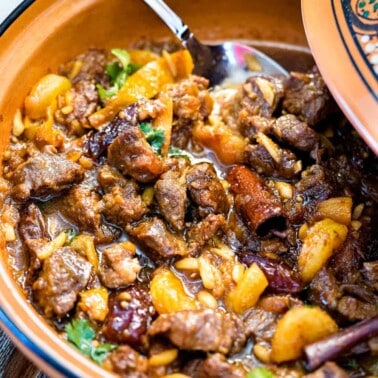
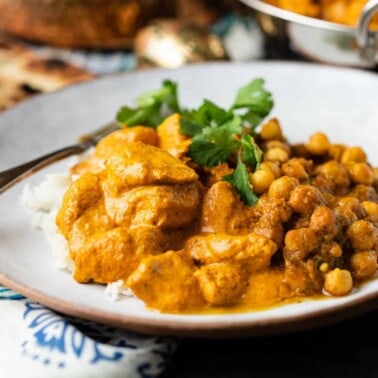
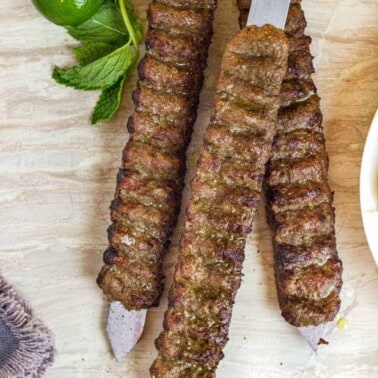








I double batch make this so I have lunch for work often, so good Kevin!
I love the flavors, thanks Jake!
Killer curry my man! My girl loved that I made this for her.
Haha! So glad the both of you enjoyed this one Bruce!
I found the S&B Curry powder and it’s wonderful. This recipe was quite delicious, too. Don’t worry about that other comment below, keep up the fantastic recipes and even the ones you put a “spin” on.
Great! Much appreciated Lois. I can’t please everyone, so glad you enjoyed this one, too.
Japanese curry never used coconut milk. Nor do we ever garnish with cilantro and limes. The only garnish ever used is fukujinzuke.
Toshio, I am using a Japanese curry powder, but the fusion recipe is my own. Thanks for your input though.
If you freestyle and add too many things that are not supposed to be in a Japanese curry then please call it Kevin’s beef curry and not Japanese beef curry.
No offense intended, thanks for dropping by Yuki.